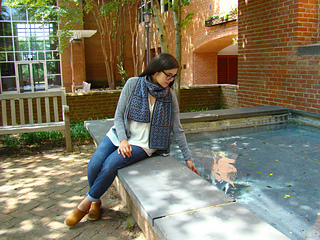patterns > Knitty >  Knitty, Deep Fall 2016
Knitty, Deep Fall 2016
> Crystalline




Crystalline
Crystalline is a double-knit scarf that uses 500 yards each of two colors of yarn.
Pattern Description
I like symmetry. Or, to be more precise, I like symmetries.
You see, I’m a mathematician, and mathematicians find patterns everywhere. We can’t help ourselves. We don’t just admire things that are symmetric, we ask questions about how they are symmetric. By a mirror reflection, like a face? By a rotation, like a pinwheel? By a translation (repetition in a straight line), like a row of toy soldiers? By a glide reflection, like footprints in the sand?
The mathematical artist Mary D. Shepherd demonstrated that in the craft of cross stitch, there are exactly twelve possible plane symmetry structures—that is, twelve fundamentally different arrangements of translations, rotations, reflections, and/or glide reflections that fill a flat plane with a repeating design. (Her explanation and accompanying artworks appear in Chapter 5 of Making Mathematics with Needlework: Ten Papers and Ten Projects, edited by sarah-marie belcastro and Carolyn Yackel.) Cross stitch conforms to a square grid, and three of these twelve symmetry types use the property that the square stitches are as tall as they are wide. This means that in a rectangular grid, like the grid formed by color work in knitting, only the remaining nine symmetry types are possible.
Armed with this mathematical framework, I set out to capture each of the nine symmetric structures with a harmonious set of designs in a double knit scarf. The result is Crystalline, so named because the symmetry types are nine of the seventeen plane crystallographic groups. (They are also called the wallpaper groups, but Wallpaper isn’t a particularly fetching pattern name.)
As a bonus, the sampler aspect of Crystalline makes it more fun to knit. On the one hand, you spend enough time with each design that the rhythm of the color pattern becomes easier as you go along. On the other hand, around the point where the current design becomes familiar enough to be boring, you’re off to a new color pattern. The combination of the extra layer of fabric in double knitting and the thin yarn and small needle make a scarf that is soft and super warm but still drapes beautifully, perfect for wrapping up as the weather turns chilly.

2155 projects
stashed
1542 times
- First published: September 2016
- Page created: September 9, 2016
- Last updated: September 10, 2016 …
- visits in the last 24 hours
- visitors right now




